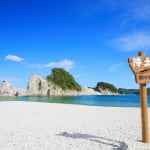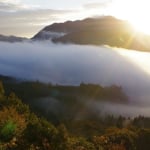Official Website:https://www.hachimantai.or.jp/
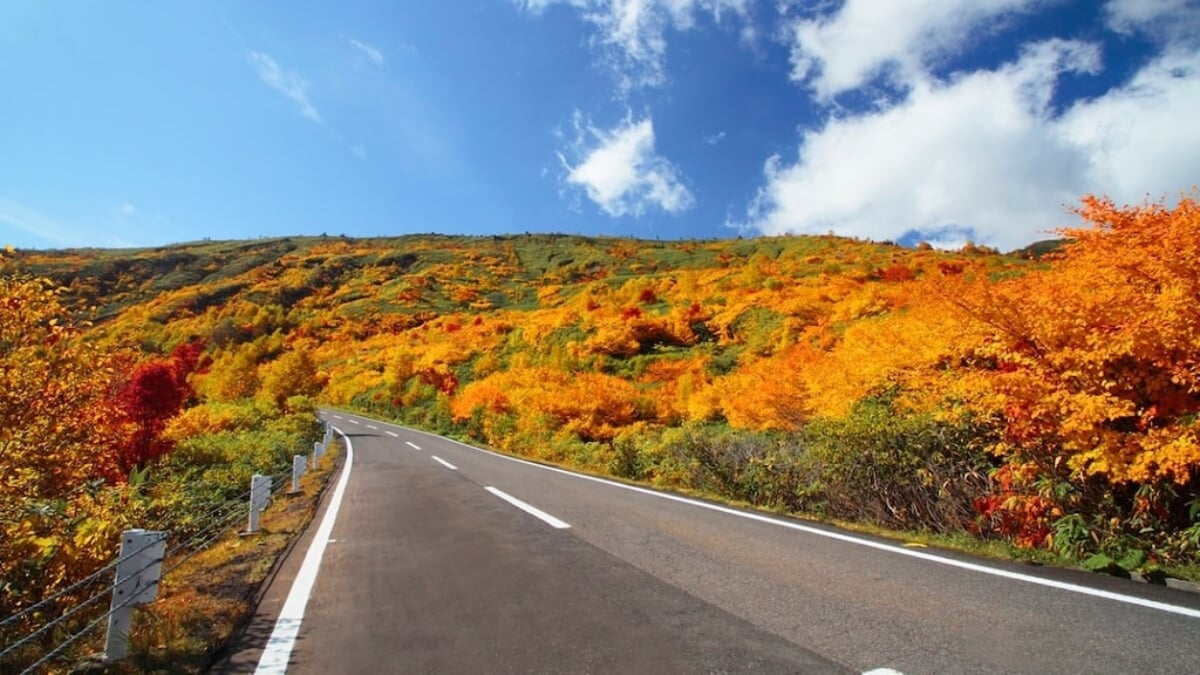
Hachimantai: A Complete Guide | Recommended Tourist Spots & Access
Located on the border between Iwate and Akita Prefectures, Hachimantai is a scenic highland destination where visitors can fully immerse themselves in nature. The name "Hachimantai" (八幡平) is pronounced "Hachimantai." A drive through its breathtaking landscapes offers a refreshing and exhilarating experience! Why not take a leisurely walk along the nature trails and wetlands, accompanied by the soothing sounds of birdsong?
Hachimantai is also known for its hidden hot springs, scattered throughout the area, making it ideal for a road trip by rental car. Here, you can feel the earth’s energy, with each season offering a different charm—cherry blossoms in spring, lush greenery in summer, golden autumn leaves, and mesmerizing frost-covered trees in winter. This guide introduces the best attractions, must-visit spots, and travel access tips to help you plan your trip to Hachimantai!
table of contents
[x] close
Hachimantai: A Complete Guide | Recommended Tourist Spots & Access
- What is Hachimantai?
- Access to Hachimantai
- 1. Drive Along the Hachimantai Aspite Line!
- 2. Hachimantai Summit Walking Trail
- 3. Gozaisho Wetlands (Hachimantai)
- 4. Goshougake Nature Research Trail
- 5. Goshougake Onsen
- 6. Toshichi Onsen
- 7. Hachimantai Snow Monsters (Juhyo)
- 8. Snow Corridor
- 9. Hachimantai Dragon Eye
- 10. Matsuo Hachimantai Visitor Center
- ◎ Explore More of Hachimantai’s Top Destinations!
What is Hachimantai?
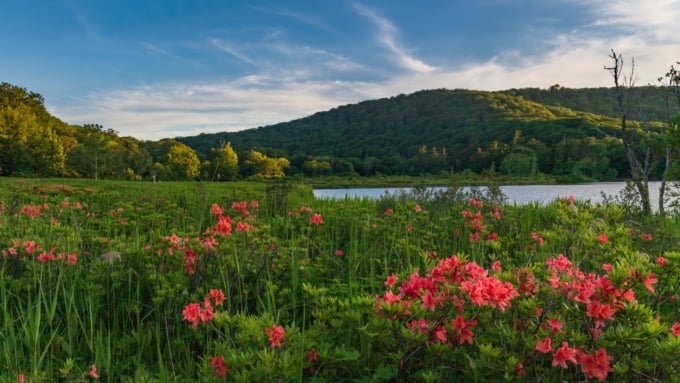
Hachimantai, spanning across Iwate and Akita prefectures, is a vast mountainous region with highlands around 1,500 meters in elevation. As a plateau-shaped volcano within the Towada-Hachimantai National Park, it offers breathtaking natural scenery, from dense forests of Aomori fir and beech trees to panoramic views of Mount Iwate’s ridgeline and vibrant alpine flora. Visitors can explore scenic trails that showcase volcanic phenomena and wetlands, making it a prime destination for nature lovers. Additionally, Hachimantai is renowned for its secluded hot springs, where travelers can enjoy a relaxing day trip or stay overnight for a rejuvenating onsen experience.
For access, the most common routes to Hachimantai are via Akita Airport, Iwate Hanamaki Airport, or by Shinkansen through JR Morioka Station and Akita Station. From there, visitors can take express or local buses, and some accommodations offer free shuttle services for guests. Renting a car is a highly recommended option for those looking to explore the highlands at their own pace while enjoying a refreshing scenic drive.
Access to Hachimantai
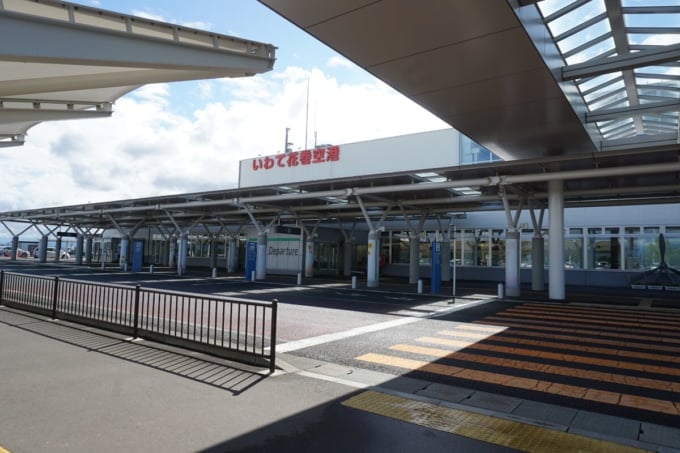
The most common way to access Hachimantai is by flying into Akita Airport or Iwate Hanamaki Airport, or by taking the Shinkansen to JR Morioka Station or JR Akita Station. From these airports and stations, travelers can take express buses, local buses, or complimentary shuttle buses available for hotel guests. For a more flexible and efficient way to explore the area, renting a car is highly recommended, allowing visitors to enjoy a refreshing drive through the highlands at their own pace.
◆ Car & Rental Cars
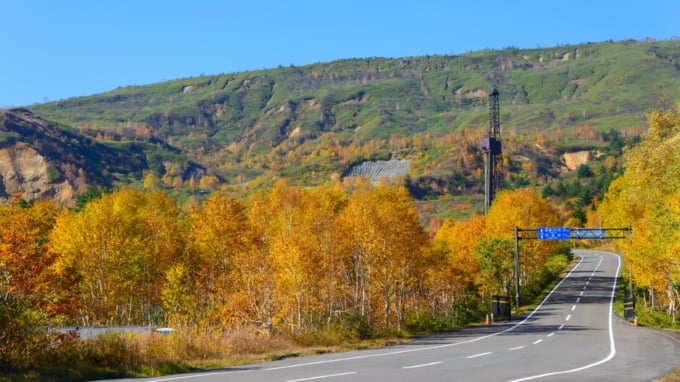
Exploring Hachimantai by rental car is highly recommended. With a car, you can stop at your favorite scenic viewpoints, take leisurely walks along nature trails, and fully immerse yourself in the breathtaking landscape. Don’t miss the chance to visit Hachimantai’s hidden hot springs and enjoy a day of relaxing onsen-hopping.
This article introduces a sightseeing route along the Hachimantai Aspite Line, starting from Matsuo-Hachimantai IC on the Tohoku Expressway. Another scenic route, the Iwate Panorama Line – Hachimantai Jukai Line, runs along the southern part of the Aspite Line, passing through Yakehashiri Lava Flow, Matsukawa Onsen, and Fukenoyu Onsen before reaching Hachimantai.
Name: Hachimantai Aspite Line / Hachimantai Jukai Line
Official Website:https://www.env.go.jp/park/towada/hachimantai/course/course_001/index.html
◆ Bus Access
You can reach Hachimantai by bus from Morioka Station, Tazawako Station, and Hachinohe Station.
The Hachimantai Nature Walk Bus is the best option for direct access to Hachimantai. It departs from Morioka Station East Exit (Platform 3) and operates daily from mid-May to mid-October.
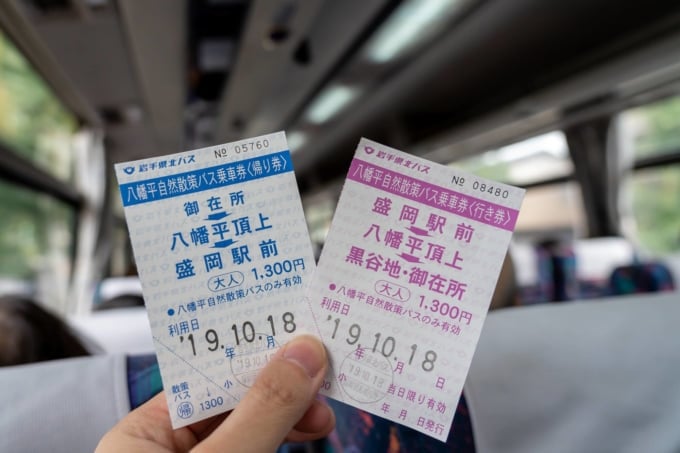
The Hachimantai Nature Walk Bus is the best option for direct access to Hachimantai. It departs from Morioka Station East Exit (Platform 3) and operates daily from mid-May to mid-October.
Convenient ticket options include one-day passes, passes for overnight stays, area-free passes, and onsen entry set tickets. A free guided tour of the Hachimantai Summit Loop Course is also available, making this a great option for visitors who want to explore Hachimantai with expert insights.
Name: Hachimantai Nature Walk Bus
Operating Company: Iwate Kenpoku Bus
Official Website:http://www.iwate-kenpokubus.co.jp/archives/14759/#ticket
1. Drive Along the Hachimantai Aspite Line!
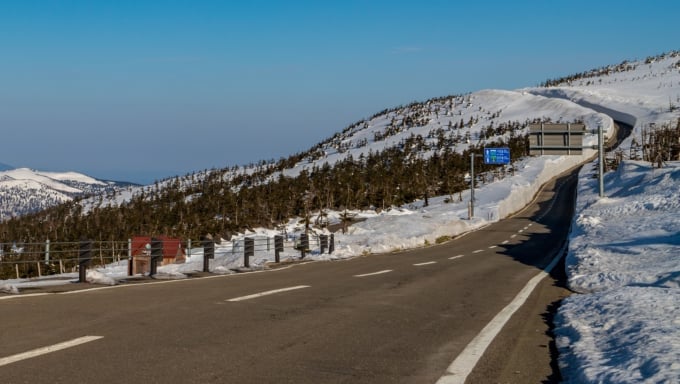
https://maps.google.com/maps?ll=39.9548,140.88513&z=13&t=m&hl=ja&gl=JP&mapclient=embed&q=%E5%85%AB%E5%B9%A1%E5%B9%B3%E3%82%A2%E3%82%B9%E3%83%94%E3%83%BC%E3%83%86%E3%83%A9%E3%82%A4%E3%83%B3
The Hachimantai Aspite Line is a breathtaking highland drive route that crosses Hachimantai. Spanning approximately 27 km, this scenic winding road is completely free to access.
Due to heavy snowfall, the road is closed during winter, but it reopens around mid-April each year with the spectacular “Snow Corridor”. The route remains open until early November, allowing visitors to enjoy everything from lush greenery in spring to vibrant autumn foliage.
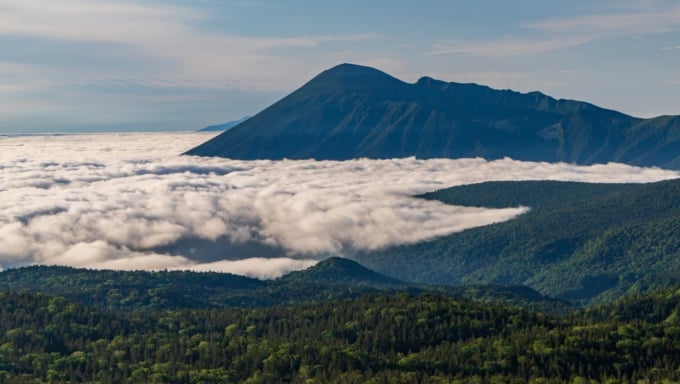
Along the Hachimantai Aspite Line, there are several scenic viewpoints with parking spaces where you can stop and admire the panoramic landscape. Enjoy a leisurely drive while taking in the majestic beauty of Hachimantai.
Here, we introduce three must-visit viewpoints along the Aspite Line, moving from east to west.
◆ Genta Rock Observatory
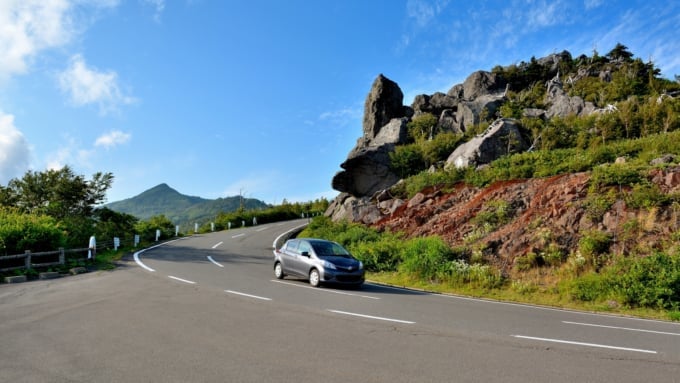
https://maps.google.com/maps?ll=39.932613,140.911697&z=14&t=m&hl=ja&gl=JP&mapclient=embed&cid=12907195158353070624
Just southwest of the Hachimantai Aspite Line Observation Point, you'll find the massive Genta Rock towering above a curve in the road!
This scenic stop offers a stunning view of Genta Rock, the surrounding sea of trees, and even the distant Mt. Iwate, making it a highly recommended photo spot.
◆ Miharashi Pass / Hachimantai Summit Parking Lot Observation Deck
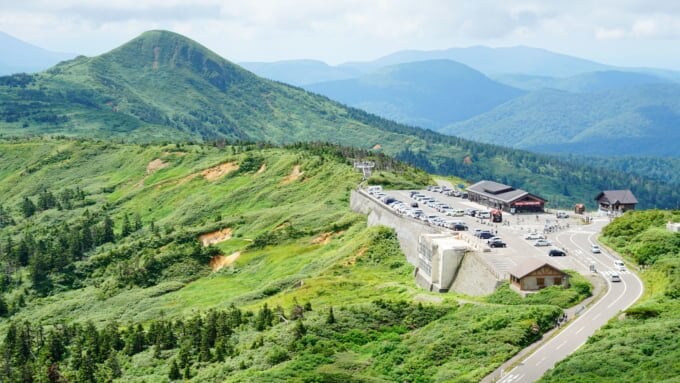
https://maps.google.com/maps?ll=39.94974,140.856733&z=15&t=m&hl=ja&gl=JP&mapclient=embed&cid=14013549448029663605
Miharashi Pass, located at the border of Iwate and Akita Prefectures, sits at an altitude of approximately 1,560 meters. This scenic mountain pass features a spacious paid parking lot and is home to the Hachimantai Summit Rest House.
At the Hachimantai Summit Rest House, visitors can enjoy a popular restaurant serving the famous Genta Curry, explore souvenir shops, and visit an information corner for travel guidance. It’s a great place to take a break before heading out to explore the area.
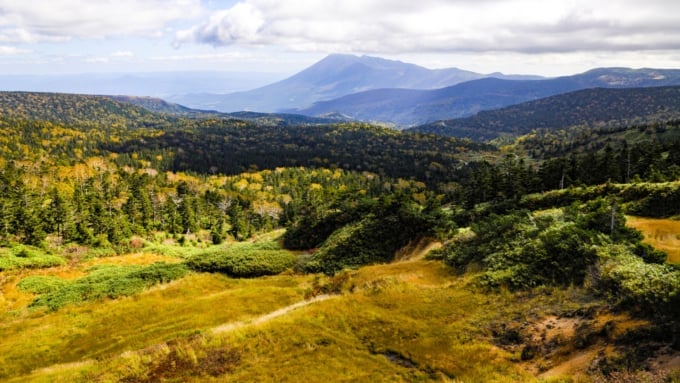
At the back of the parking lot, there is a wooden deck observation platform. Climbing up to the deck rewards visitors with a breathtaking 360-degree panoramic view of the surrounding landscape.
Name: Hachimantai Summit Rest House
Official Website:https://www.hachimantai.or.jp/rest_house/index.html
◆ Oobukasawa Observatory
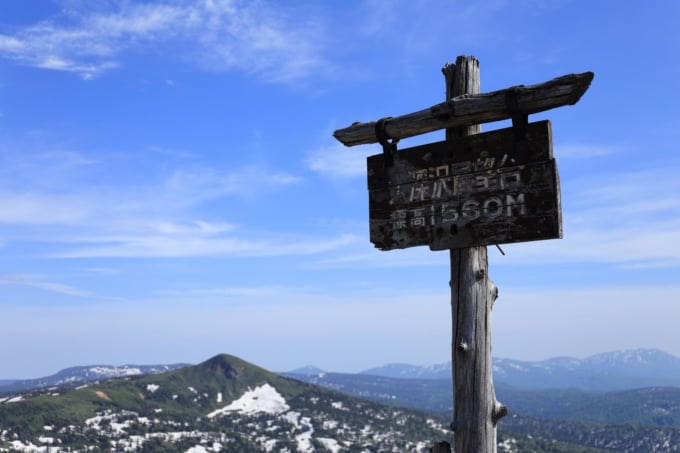
https://maps.google.com/maps?ll=39.956813,140.841565&z=14&t=m&hl=ja&gl=JP&mapclient=embed&cid=9691284727932471060
Oobukasawa Observatory is a stunning viewpoint located just a few minutes west of the Hachimantai Summit Parking Lot along the roadside. This scenic spot offers an open and unobstructed view of the surrounding mountains.
There are two small parking areas nearby, making it a convenient stop for travelers looking to take in the breathtaking scenery.
2. Hachimantai Summit Walking Trail
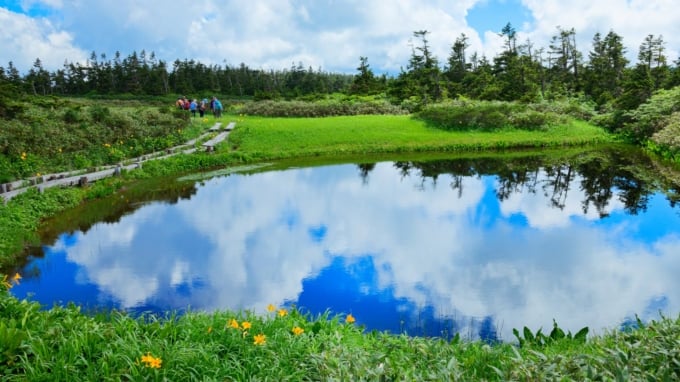
The Hachimantai Summit Walking Trail is a popular tourist spot where visitors can easily enjoy trekking. This well-maintained trail takes approximately an hour and a half to complete, making it ideal for beginners and tourists seeking a leisurely nature walk.
The trail begins just across the road from the Hachimantai Summit Parking Lot. As you walk through the wooden pathways of the wetland area and pass Hachimannuma Pond, you will reach the Hachimantai Summit Observatory. A short five-minute ascent from the observatory leads to the very peak of Hachimantai.
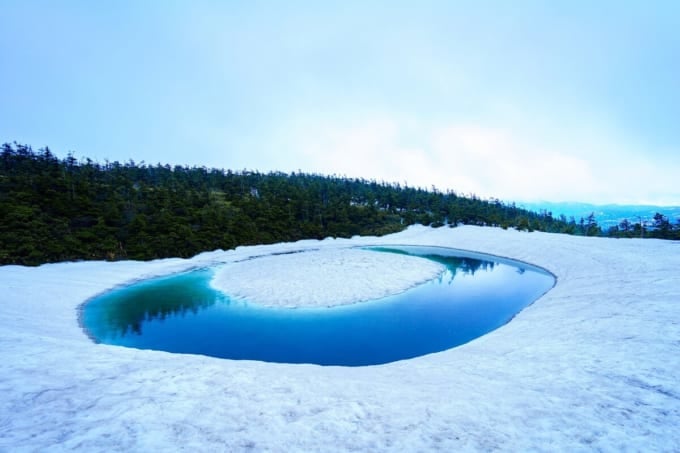
Along the way, you’ll encounter breathtaking sights, including the stunning Gama-numa Pond, Megane-numa Pond, and the famous Kagami-numa Pond, known as the “Dragon Eye”. The course then loops back to the parking lot, offering a scenic hiking experience filled with highlights.
Visitors can also admire alpine flora such as cotton grass and Nikkō kisuge (yellow alpine lilies), which thrive in the high-altitude environment. If you're lucky, you might even spot the Asagimadara butterfly, a migratory butterfly known for its long-distance travel.
https://maps.google.com/maps?ll=39.950201,140.856242&z=15&t=m&hl=ja&gl=JP&mapclient=embed&cid=1674292215951804277
For a detailed map of the Hachimantai Summit Walking Trail, visit the official website:
https://www.hachimantai.or.jp/trekking/file/2024shizensansaku.pdf
3. Gozaisho Wetlands (Hachimantai)
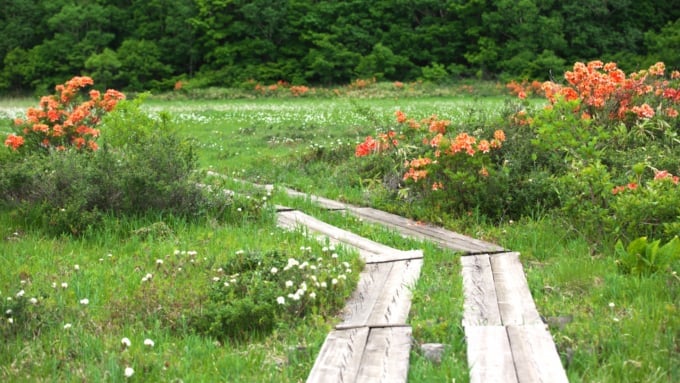
https://maps.google.com/maps?ll=39.947274,140.939686&z=16&t=m&hl=ja&gl=JP&mapclient=embed&cid=16304882241680632991
The Gozaisho Wetlands (Gozaisho Shitsugen) is a high-altitude wetland located on the eastern side of the Hachimantai Aspite Line. Known as a paradise for alpine flora, it is home to a wide variety of highland plants, including mizubashō (Asian skunk cabbage) and cotton grass, which flourish in the area.

The wetland features a walking path that allows visitors to explore the surrounding landscape, including Gozaisho-numa Pond and Goshiki-numa Pond (Red Pond), in approximately 90 minutes. One of the highlights of the season is the grass autumn foliage, which reaches its peak from late September to early October. If you're planning a visit during the autumn season, this natural wonder is a must-see.
For more information about Gozaisho Wetlands, visit the official website:
https://www.hachimantai.or.jp/area/area03.html
4. Goshougake Nature Research Trail
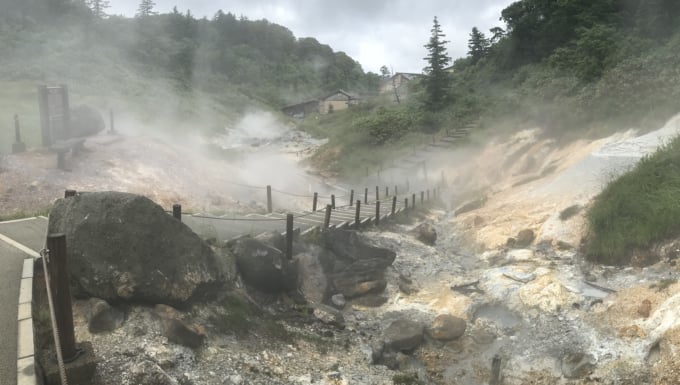
https://maps.google.com/maps?ll=39.971907,140.800748&z=16&t=m&hl=ja&gl=JP&mapclient=embed&cid=18348967168570643359
Located in the western part of the Aspite Line, the Goshougake Nature Research Trail (後生掛自然研究路) offers a rare glimpse into unique volcanic phenomena. The entrance to this scenic trail can be found behind Goshougake Onsen Ryokan, and visitors can conveniently park their vehicles at the ryokan's parking lot.
The trail features a well-maintained walking path for a “hell tour” experience, complete with a small shop along the route. As you stroll through the area, you can observe bubbling mud pots (mad pods) and boiling springs, making for a fascinating exploration of natural geothermal activity.
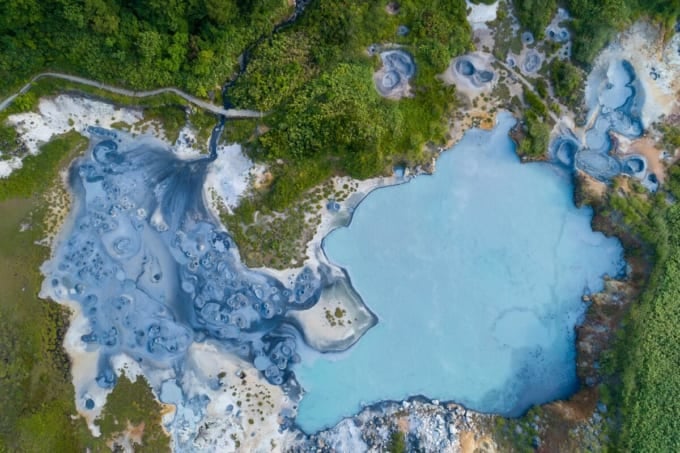
Viewing the Goshougake Nature Research Trail from the air offers an even more stunning perspective, showcasing the dynamic volcanic landscape in its full glory.
At the end of the trail, you will reach Oyunuma, a steaming pond filled with active boiling springs and mud pots. This area is constantly expanding westward, causing some sections of the circular path to be closed.
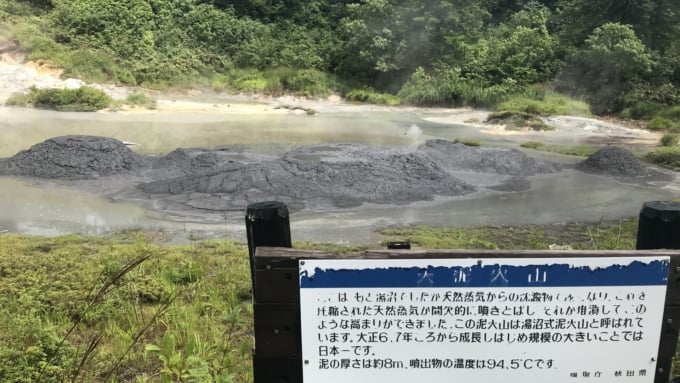
While visitors can choose to return at this point, those with extra time should continue on to see the Great Mud Volcano—one of Japan’s largest and most remarkable mud volcanoes, believed to have been growing since around 1917 (Taishō 6). The path to the Great Mud Volcano is slightly rough, but witnessing this rare geological wonder makes the journey worthwhile.
For more details, refer to the official Goshougake Nature Research Trail map (PDF):https://www.goshougake.com/wp-content/uploads/2022/02/map_nature_road.pdf.
5. Goshougake Onsen
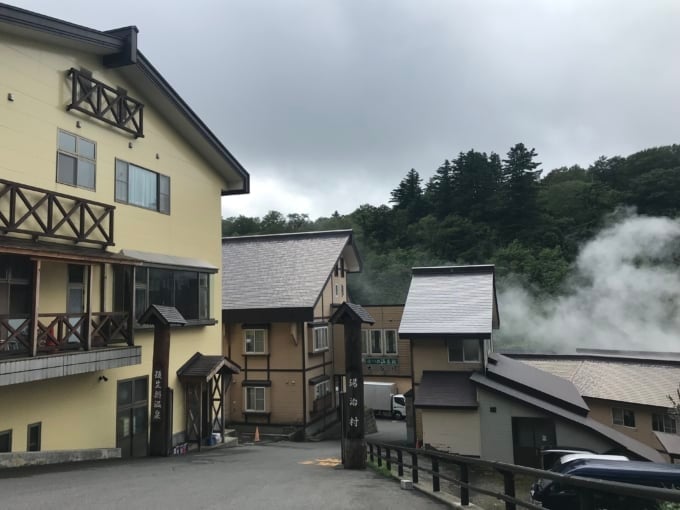
After exploring the Goshougake Nature Research Trail, visitors should take the opportunity to relax at Goshougake Onsen, conveniently located at the entrance of the trail. This historic hot spring is well-known for its therapeutic mud baths, where guests can soak in naturally occurring mud-infused waters.
The mud in the Goshougake Onsen bath comes directly from the geothermal activity observed along the trail, accumulating at the bottom of the bathhouse's pools. The waters are rich in sulfur and minerals, creating a milky-gray hue that is said to provide numerous health benefits. In addition to the mud bath, visitors can experience steam saunas and box steam baths, all utilizing the natural geothermal heat of the area.
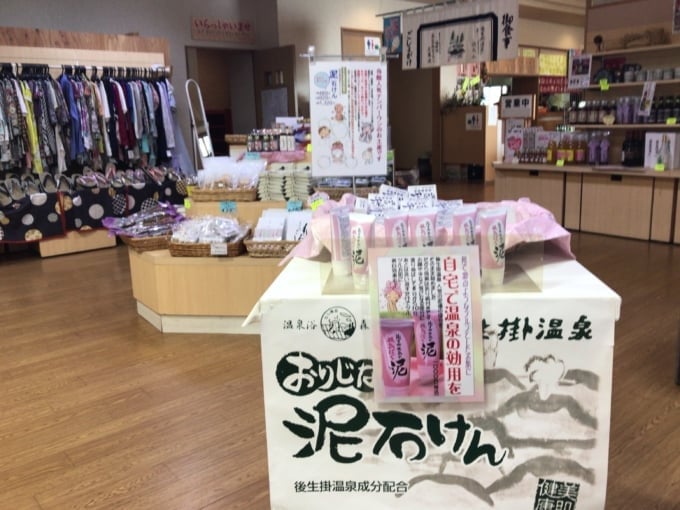
Adjacent to the onsen, the Goshougake Onsen Shop offers a selection of original souvenirs, including “mud soap”, which is a unique gift from this volcanic hot spring. Visitors can also enjoy a meal at the onsen’s in-house restaurant, making it a perfect spot to unwind after a day of exploration.
Address: Hachimantai, Kazuno City, Akita Prefecture, Japan
Official Website:https://www.goshougake.com/
6. Toshichi Onsen
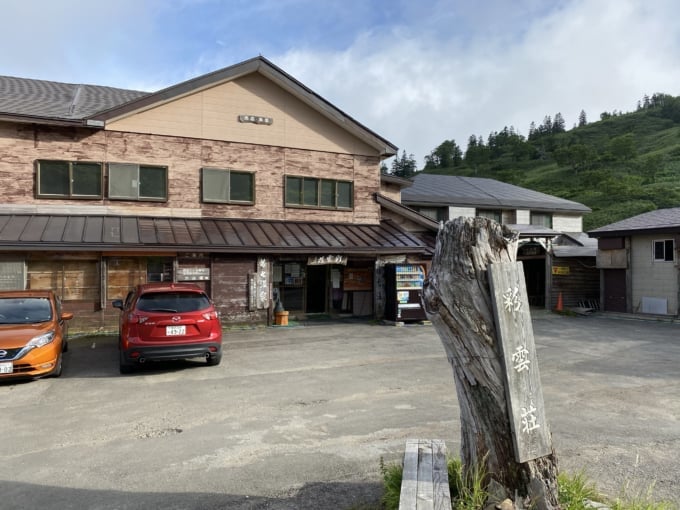
https://maps.google.com/maps?ll=39.941836,140.861232&z=16&t=m&hl=ja&gl=JP&mapclient=embed&cid=10729699489810437660
Toshichi Onsen "Saiunso" is one of Hachimantai's most prized hot springs, located at an altitude of approximately 1,400 meters, making it the highest hot spring in eastern Japan.
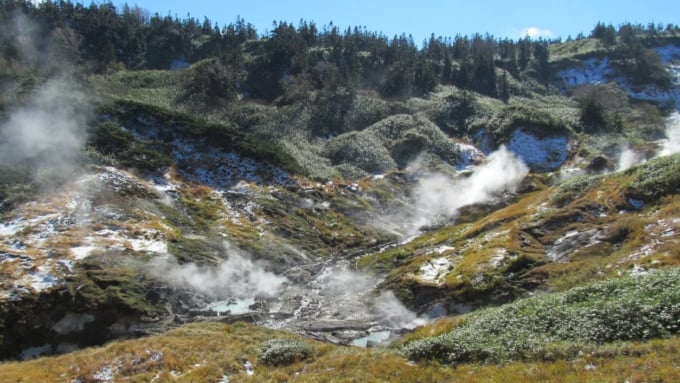
The highlight of Toshichi Onsen is its open-air bath, where visitors can take in a breathtaking 360-degree panoramic view. Whether watching the sunrise, admiring the sea of clouds, or soaking in the ever-changing seasonal landscapes, the experience is truly unforgettable. During autumn, the surrounding mountains turn into a spectacular tapestry of red and gold, offering a mesmerizing sight while you relax in the hot spring.
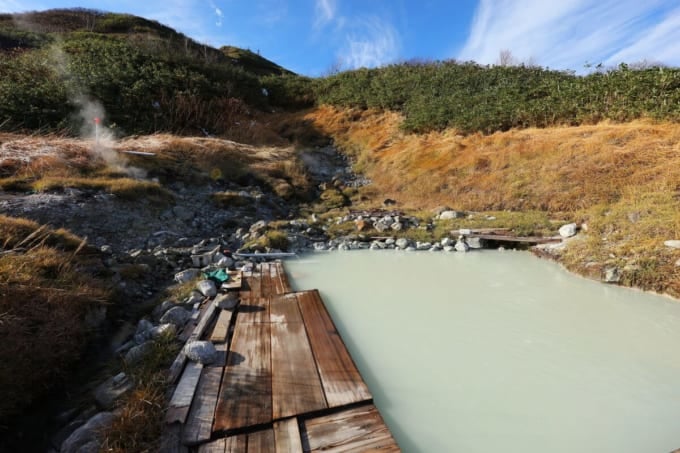
The hot spring area features multiple baths, including five mixed-gender open-air baths, one exclusively for women, and private bathing areas for overnight guests. Women can also purchase large bath towels for mixed bathing. The hot spring water is a natural sulfur spring, flowing directly from the source, creating a milky-white bath with gentle bubbling from beneath the pools. Visitors can also enjoy a natural mud pack, leaving their skin feeling smooth and rejuvenated.
After a soothing bath, unwind in the relaxation areas or enjoy a hearty meal at the on-site dining facility. The menu features an all-you-can-eat selection of vegetable curry, soba, tempura, and mountain vegetables. A must-try specialty is the "seasoned black hot spring egg," available at the front desk.
Name: Toshichi Onsen
Address: Matsuo Yoriki Kitanomata, Hachimantai City, Iwate Prefecture
Official Website: https://www.toshichi.com/
7. Hachimantai Snow Monsters (Juhyo)
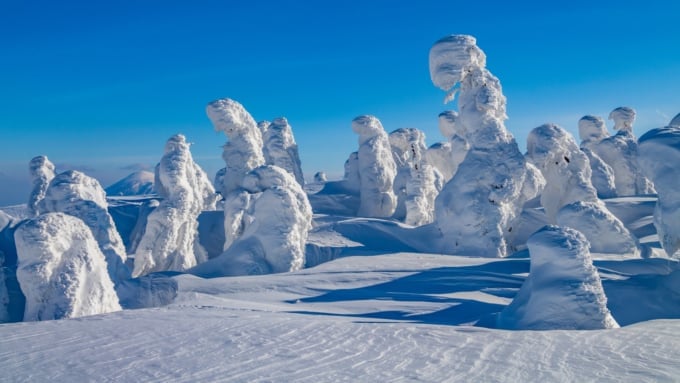
In the area around Genta Forest and near the Mikaeri Pass at the summit of Hachimantai, a spectacular natural phenomenon occurs every winter. From December onwards, the dense Aomori Todomatsu (fir) trees transform into an otherworldly landscape of snow-covered formations known as "juhyo" or "snow monsters." These formations, created by frozen mist and heavy snowfall, take on unique and distinct shapes, making them a breathtaking sight.
A thrilling way to witness these frozen wonders is by joining the Hachimantai Juhyo Tour. The Appi Kogen Nature School, located on the first floor of Hotel Appi Grand, offers two types of snow vehicle tours. Experienced adventurers can opt for a backcountry tour, while beginners and families with children (ages 10 and above) can enjoy the snowshoe tour. Since reservations are required, it is recommended to book your tour in advance before visiting Hachimantai. The magnificent scenery created by nature during this season is a must-see experience.
For those who want to take home a souvenir, a popular treat inspired by the juhyo is available in Hachimantai. These unique confections feature marshmallows sandwiched between cookies and coated in chocolate, replicating the fluffy, snow-covered appearance of the famed snow monsters.
Name: Hachimantai Snow Monsters (Juhyo)
Address: Hachimantai City, Iwate Prefecture
Official Website: https://akita-hachimantai.jp/sp/no11.html
8. Snow Corridor
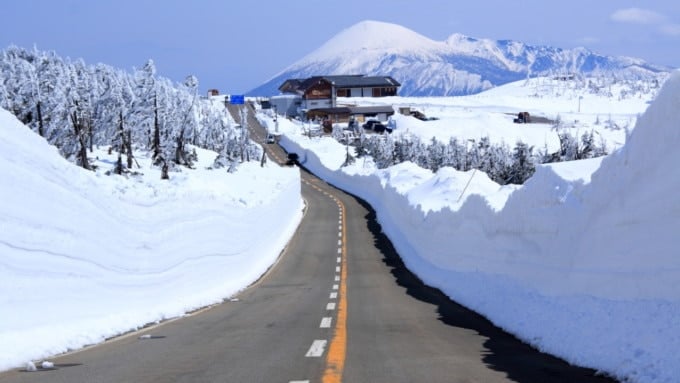
As the harsh winter comes to an end, spring arrives in Hachimantai. The Hachimantai Aspite Line, a scenic 27-kilometer road that remains closed during winter due to heavy snowfall, reopens in April. When the road is cleared, towering snow walls measuring around 7 to 8 meters in height are formed, creating the breathtaking “Snow Corridor.”
The Snow Corridor in Hachimantai is even taller than the famous one in Hakkoda, and its viewing period lasts until early May, making it a unique and long-lasting seasonal spectacle. The contrast between the towering white snow walls and the clear blue sky makes for a magical and unforgettable drive through this winter wonderland.
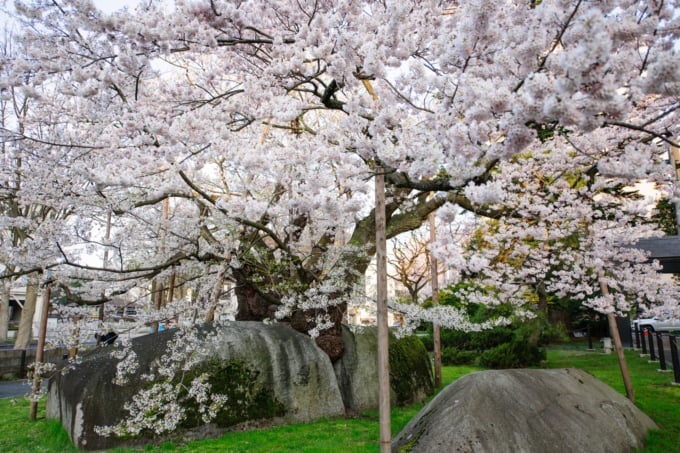
During this time, the surrounding areas also enter full bloom, including the Ishiwari-zakura (Rock-Splitting Cherry Tree) in Morioka, a nationally designated natural monument, and the beautiful weeping cherry blossoms of the Samurai District in Kakunodate. Hachimantai offers a rare opportunity to witness both snow and cherry blossoms in a single trip. Why not enjoy the Snow Corridor and then indulge in the breathtaking beauty of the Cherry Blossom Corridor for an unforgettable spring experience?
Location: Matsuo Yoriki, Hachimantai City, Iwate Prefecture
Official Site:https://www.tohokukanko.jp/attractions/detail_1007.html
9. Hachimantai Dragon Eye
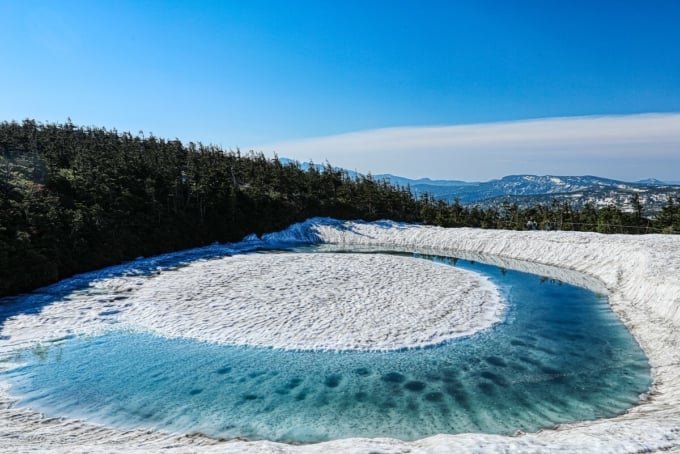
The Hachimantai Dragon Eye is a rare and mystical natural phenomenon that occurs at Kagami-numa Pond along the Hachimantai Summit Trail. This mesmerizing sight appears only from late May to early June, drawing attention on social media for its mysterious beauty.
As spring arrives in Hachimantai, melting snow and water from the surrounding area flow into Kagami-numa Pond, causing the remaining ice to lift and break apart in a circular pattern. The center gradually melts, forming an eye-like shape that resembles a dragon’s eye—a breathtaking spectacle created by nature’s miracle. The colors and exact timing of the Dragon Eye’s appearance vary each year, making it an even more exciting and unpredictable experience.
The hike to Kagami-numa Pond takes approximately 15 minutes from the Hachimantai Summit Parking Lot. Visitors are advised to stay within designated areas and avoid crossing safety ropes for their protection.
https://maps.google.com/maps?ll=39.954187,140.854221&z=15&t=m&hl=ja&gl=JP&mapclient=embed&cid=8470604581403062409
Location: Kagami-numa Pond, Hachimantai
Official Site:https://www.tohokukanko.jp/attractions/detail_1008294.html
10. Matsuo Hachimantai Visitor Center
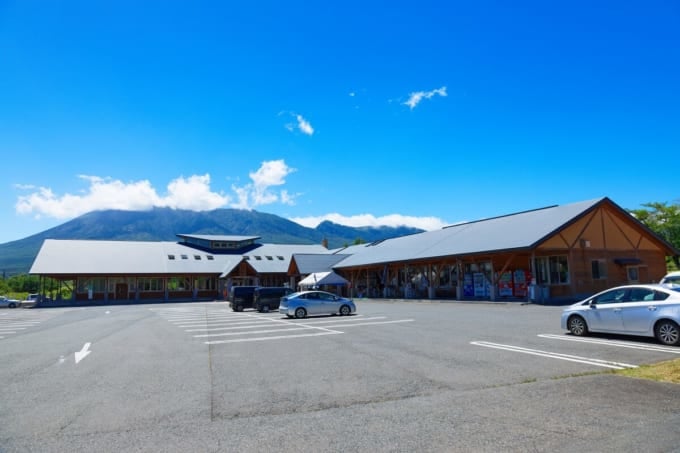
Near the entrance of the Hachimantai Aspite Line, you’ll find the Matsuo Hachimantai Visitor Center, a key hub for tourist information about Hachimantai and Mount Iwate. This facility offers an immersive learning experience through high-definition videos detailing the geological formation of the area, along with diorama models, exhibits of alpine plants, and specimens of butterflies and insects native to Hachimantai. Visitors can explore and enjoy the region’s natural wonders while learning about its unique ecosystem.
Right next to the visitor center, Bussankan Aspite is a popular marketplace where you can buy locally produced fresh agricultural goods, traditional handicrafts, and handmade accessories. With an extensive selection of dyed fabrics, ornaments, and charming souvenirs, the market is a must-visit for both local shoppers and tourists seeking authentic Hachimantai keepsakes.
https://maps.google.com/maps?ll=39.92013,140.975399&z=15&t=m&hl=ja&gl=JP&mapclient=embed&cid=9515681562170251756
Address: 1-28 Kashiwadai, Hachimantai City, Iwate Prefecture, Japan
Official Websites:
https://www.hachimantai.or.jp/visitor_center/index.html
https://www.hachimantai-ss.co.jp/aspite/index.html
◎ Explore More of Hachimantai’s Top Destinations!
Hachimantai is renowned for its diverse landscapes and breathtaking natural scenery. Every season brings a unique charm, making it an exciting destination year-round. Be sure to explore some of the area's top tourist attractions, including:
◆ Tamagawa Onsen
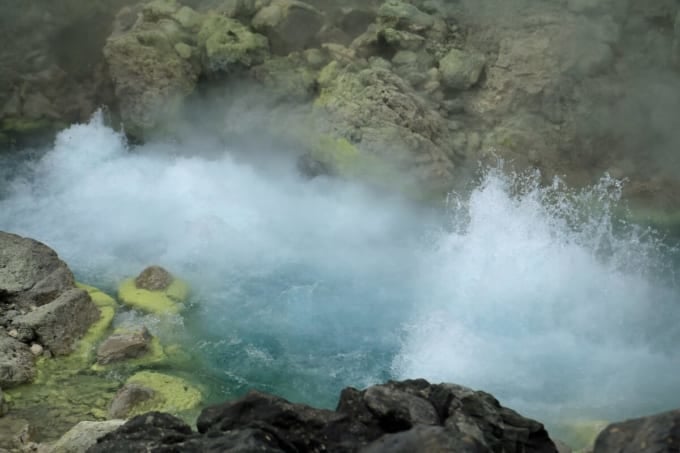
Tamagawa Onsen is famous for having Japan’s highest hot spring water output and the most acidic waters in the country. Located about a 30-minute drive from Goshougake Onsen via National Route 341, this hot spring is known for its healing properties—some even believe it can cure serious illnesses.
Visitors can experience the natural bedrock baths and the Tamagawa Onsen Nature Research Trail, where the earth’s geothermal energy creates a surreal, otherworldly atmosphere. It’s truly a unique and rejuvenating retreat that offers a one-of-a-kind spa experience in the heart of nature.
Name: Tamagawa Onsen
Address: Shibukurozawa, Tamagawa, Tazawako, Semboku City, Akita Prefecture
Official/Related Website URL: https://www.tamagawa-onsen.jp/hot_stoned_bath/
◆ Appi Kogen: A Year-Round Resort Destination
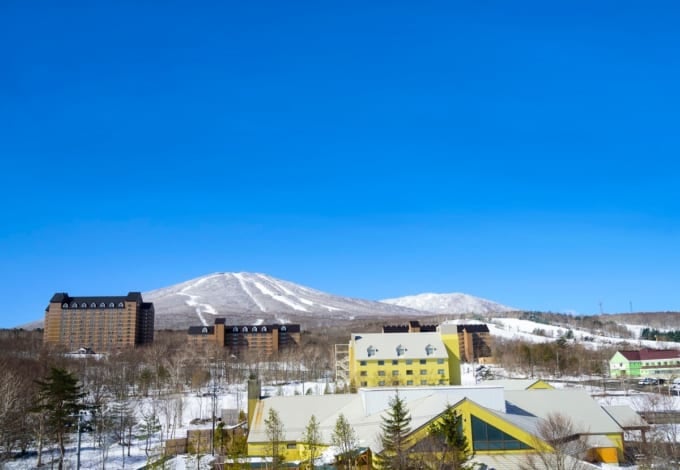
Located in the northeastern part of Hachimantai, Appi Kogen is one of the largest resorts in the Tohoku region, making it a must-visit destination alongside Hachimantai. Visitors can enjoy a variety of activities, such as interacting with animals at the ranch, exploring the scenic highlands, or experiencing adventure-based attractions. During winter, Appi Kogen transforms into a popular ski resort, drawing in skiers and snowboarders from all over.
◆ Iwatayama Yakehashiri Lava Flow
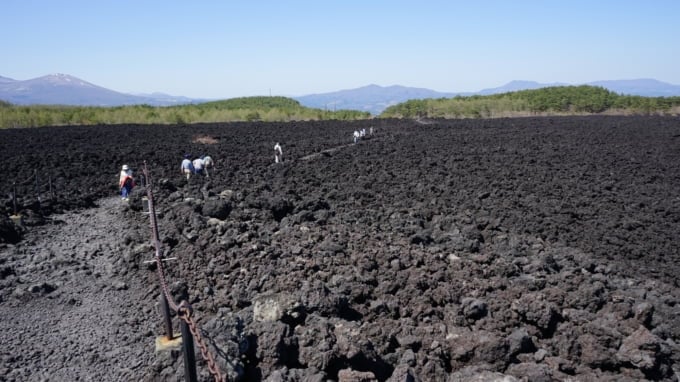
As you descend the Hachimantai Jukai Line and continue from Matsukawa Onsen to the Iwatayama Panorama Line, you will encounter a unique geological site—Iwatayama Yakehashiri Lava Flow, designated as a National Natural Monument of Japan.
This vast expanse of black, hardened lava stretches approximately 3 km in length and 1 km in width, forming a dramatic fan-shaped landscape. The lava field was created by a past eruption of Mount Iwate, solidifying into an otherworldly terrain that exudes both beauty and a sense of raw power.
For ease of access, a parking area is available at the entrance, making it convenient for travelers arriving by car. Nearby, you’ll also find the Iwatayama Yakehashiri International Exchange Village, which features a day-use hot spring—perfect for relaxing after exploring the rugged lava formations.
Name: Mt. Iwate Yakehashiri Lava Flow
Address: Hirakasa District, Hachimantai City, Iwate Prefecture (within national forest land)
Official/Related Website URL: https://iwatetabi.jp/spots/5585/
RELATED ARTICLES
REGIONS
CATEGORIES
FEATURED ON Iwate
-

5 Recommended Tourist Spots in Karumai Town, Iwate Prefecture – Enjoy Nature!
-
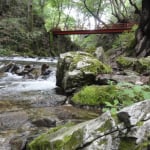
Let’s be healed by the magnificent nature that Iwate is proud of! 4 Recommended Power Spots in Iwate Prefecture
-

[2025] Enjoy Illuminations and Ice Caves at Mahora Iwate’s “World of Ice”!
-

6 Must-Try Experience Spots You Should Visit in Iwate
-
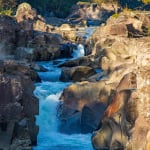
[3-Day Autumn Weekend] Must-Visit Destinations in Japan This September – Avoid the Crowds!
MOST POPULAR ON Iwate
-
 1
1Doha: Must-see Attractions in the Capital of Qatar
-
 2
2Toronto: 10 Things to do in this Picturesque Canadian City
-
 3
3Amarillo: A City Famous for It’s Amazing Canyons, Great History and Music
-
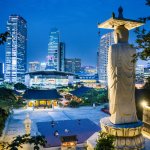 4
4South Korea: Dazzling Scenery, Rich Culture and Fascinating History
-
 5
5Kuwait: A Country in Middle East Asia Famous for Hot Sand Dunes and Stunning Cityscape


